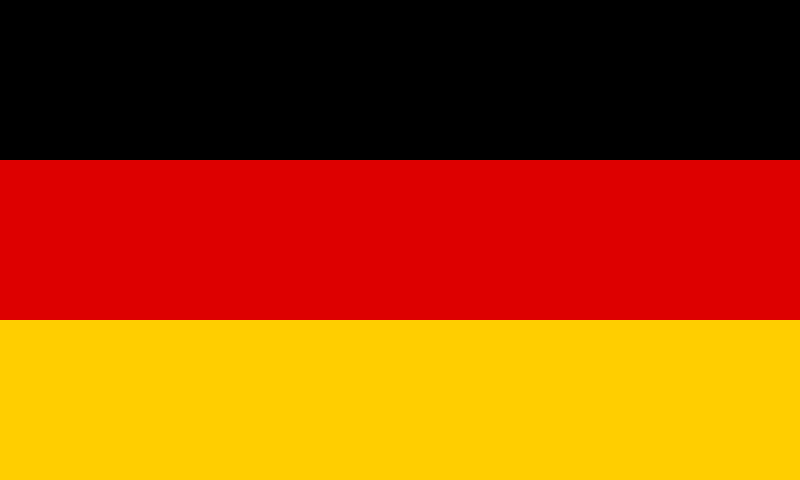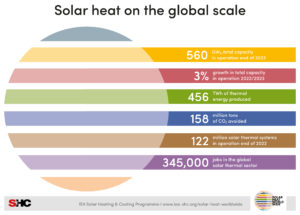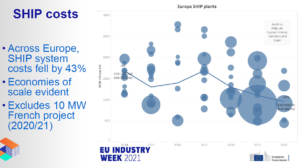Germany: Feed-in Tariff Changes May Benefit Solar Heat
September 22, 2014
Whereas Germany’s total collector sales are dropping, solar thermal companies see a glimmer of hope for big projects because of changed feed-in tariffs in the renewable electricity sector. So far, the cogeneration of heat and power has been the strongest competitor of large-scale solar heat for district heating and industrial projects. Because cogeneration had been a very attractive solution in terms of electricity prices, even a subsidy recovering all costs of a solar thermal investment wouldn’t have tipped the scales in favour of solar heat, a study by Fichtner stated in autumn of 2013. Now, however, cogeneration is starting to lose ground.
The recent amendment to the Renewable Energy Sources Act (Erneuerbare-Energien-Gesetz, EEG) requires owners of cogeneration plants which have started operations after 1 August 2014 to pay 30 % of the EEG surcharge, if they exceed 10 kW or installed capacity or 10 MWh of self-produced and self-consumed electricity yearly. This surcharge per kWh of electricity, which is used to finance the feed-in tariff for renewable energies, will even increase to 35 % in 2016 and to 40 % in 2017. The surcharge has been at EUR 0.0624 per kWh in 2014 and is expected to decrease to between EUR 0.058 and 0.062 next year.
Surcharge on self-produced electricity for cogeneration plants
The German association for cogeneration energy, the Bundesverband Kraft-Wärme-Kopplung (B.KWK), fears that the surcharge is going to strongly affect the numbers of new cogeneration plants. According to a press release from June 2014, the Vice President of B.KWK, Martin Maslaton, even sees the new law in conflict with the German constitution.
At the same time, there has been a drop in the wholesale electricity price traded at the European Energy Exchange in Leipzig, Germany. To a large extent, this drop is a result of an increased use of solar and wind, both technologies which help reduce fossil energy demand. Cogeneration plants now have to compete with very cheap grid electricity, if the plant is used to supply the owner’s power needs, and if the produced electricity is to be sold, the diminished returns won’t help as well. Because photovoltaic electricity production peaks at noon and in summer, the price of electricity is especially low during these periods. When it is too low for a profitable operation of cogeneration plants, their operators use boilers instead. This means that heat is no longer an almost-free by-product of electricity production, as it had been for a long time. Good news for solar heat, as large-scale solar thermal plants then have a chance to compete with boilers, especially in summer.
Low electricity prices favour electric heating and heat pumps
Overall, cogeneration plants have been losing their attractiveness across Germany over the past couple of years. But many district heating networks rely on heat from these plants. Boilers are used wherever the plants’ operation is no longer economically feasible. “This means that large-scale solar district heating has a chance if it can offer low-cost solar heat at prices of around 0.045 to 0.05 EUR/kWh,” the spokesperson of the Process Heat working group at the solar industry association BSW Solar, Ralf Orths, said. Another point in favour of solar may be that in January 2015, the first ordinance on the Federal Immission Control Act will introduce stricter regulations on the emissions of small and medium heating plants.
It is not certain whether a decreasing interest in cogeneration plants will actually help solar thermal. “Cautiously optimistic” is Orths’s view on the market. Low electricity prices, caused by the excessive production from wind turbines and photovoltaic systems, are benefitting other competitors of solar heat: heat pumps and electric heating.
In addition, grid operators sometimes have to get rid of a certain amount of electricity to keep the grid frequency stable, a “negative balancing energy” which, for example, can be provided by big electricity consumers switched on whenever grid operation requires it. Municipal utility Stadtwerke Flensburg entered the market for balancing energy two years ago. Now, they are getting paid for taking excess energy off the grid whenever the grid operator needs it to be done. They use the excess electricity to generate heat for their district heating network. Hamburg Energie is also looking at this option, in order to supply their solar-supported centrally heated Energiebunker, but have not started any project on it yet. Although negative balancing is a very attractive option for district heating companies, the balancing energy market is only designed for production and consumption fine-tuning, which means that the total amount of energy traded here is limited.
Solar thermal heat price fixed over 25 years
Still, companies specialising in large-scale solar thermal projects see an opportunity to enter a new market. In June, Austrian company S.O.L.I.D. set up a sales office in Germany; in July, Danish company Arcon founded a German subsidiary called Arcon Fernwärme GmbH. Arcon Fernwärme’s Managing Director, Christian Stadler, says: “The cost for heat generation by different technologies will be very difficult to predict over the next years. Big heat consumers and district heating companies are always looking for alternative technologies for heat generation. Solar thermal plant calculations are simple: A one-time investment and low maintenance costs provide the basis for a 25-year fixed heat price.”
According to Joachim Nitsch from the German Aerospace Centre’s Institute of Solar Research, DLR, the introduction of the EEG amendment will more than ever require strong solar thermal growth. The new law will drastically slow down the growth of biomass cogeneration plants, which produce a large share of today’s renewable heat, and solar thermal needs to fill the gap, in order for the government to meet its climate production and renewable energy targets. But Nitsch is less optimistic than Stadler: “We would need a lot more incentives, especially for large-scale solar thermal, such as district heating, seasonal storage and solar process heat. The European regulation on energy efficiency would even allow making it mandatory for municipalities to develop long-term heating concepts, including renewable energy projects, for their districts. Denmark could serve as a model. But I don’t see any signs of Germany moving in this direction.”
Fichtner, the consulting agency which published the study on cogeneration and solar thermal in 2013, is also sceptical that the new EEG will push solar thermal. “With the new EEG, highly efficient cogeneration plants that were built after 1 August 2014 have to pay a share of the EEG surcharge as well. These additional costs cut the advantage of cogeneration compared to solar thermal, but they do not change the fact that solar thermal cannot compete with cogeneration for process heat applications,” Dr Achim Stuible, who is responsible for the Division Energy Economy and Environmental at Fichtner, says.
More information
Erneuerbare-Energien-Gesetz (see § 61 for surcharges on self-produced electricity, only in German): http://www.gesetze-im-internet.de/eeg_2014/
Stadtwerke Flensburg: http://www.stadtwerke-flensburg.de
Energiebunker project by Hamburg Energie: http://www.iba-hamburg.de/en/projects/energiebunker/projekt/energy-bunker.html
S.O.L.I.D.: solid.at/en/
Arcon: http://www.arcon.dk


